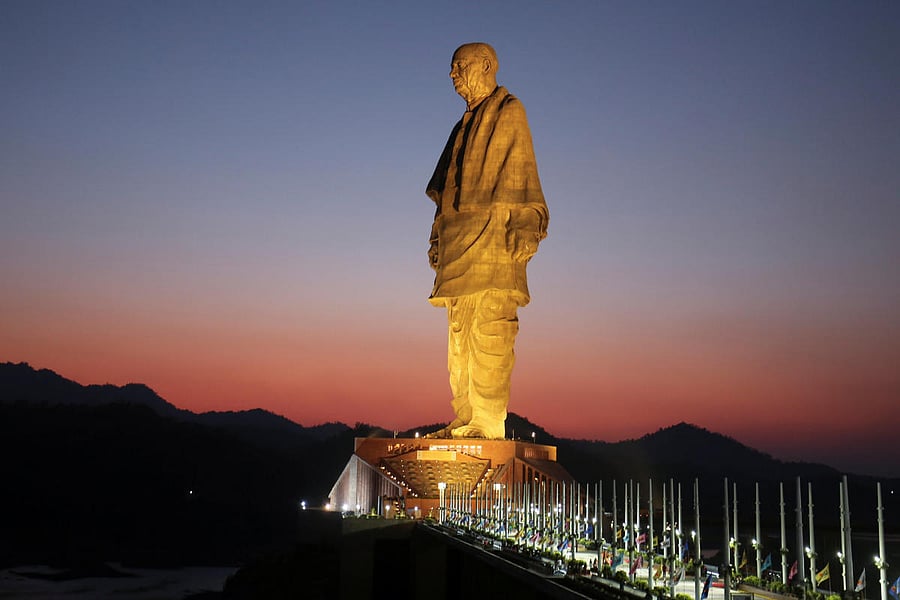We should now feel on top of the world. We may not be the world’s largest economy or sanest society, but never mind, we can now boast of the world’s tallest statue.
Human awareness is poised at all times dynamically between the objective and the subjective. All genuine sources of strength, with regard to individual persons, dwell and are derived from inwardness. The enduring strengths of a human being are interior to oneself.
Walking with the help of a walking stick, for instance, is a sign of disability, not empowerment. We cannot live on borrowed strengths and passions. Nor can we derive nourishment from someone else’s alimentation or are empowered by the scholarship even of the closest of our friends and relatives.
But politics and culture are domains of objectification. Ethically and spiritually, nothing is really ours unless it is within us. Culturally, nothing is real unless it is projected in the impersonal space out there. You may be, potentially, an artistic genius, but you will count for nothing until you project your inward genius on to the canvas of objectivity in the form of works of art.
But the catch is that the moment you objectify your genius, you throw yourself open to the manipulation of others. Even artistic novices can condemn you at will. You lose control over what you create the moment you put it into the public sphere. Someone other than you puts up a price tag on it.
This affords an insight into why history is dotted with attempts to objectify identities, ideals and ideologies. Narendra Modi is not the first man in history to conceive the idea of overpoweringly gigantic monuments. The Bible records the story of a people — the dwellers in Babel — who sought to objectify their aspirations for unity through a heaven-kissing tower. Their gigantic effort ends in utter confusion. History has the last laugh on Project Babel, with its Tower of Unity. It ends up in the scattering of the people over the face of the earth.
Historians caution us that the obsession with size or magnitude is a sign of corporate decay and ethicists explain why. These cultural monuments — whose function it is to impress and dwarf us, the common-folk — signal an emerging and perilous imbalance: the imbalance between the inner and the outer, the subjective and the objective in the life of a people.
What is the problem in this shift? The worth and empowerment of the individual has a necessary reference to his interiority. To the extent that he discovers and consolidates his inner worth and resources, the importance of external markers and manipulators of collective pride, material achievement, and the power of propaganda, decline.
The more the individual develops, the less inclined he is to hero-worship. Hero-worship is predicated on the dwarfing, the inflicted insignificance, of a people. To worship a fellow human being, one has to be less than human, less than oneself.
This hollowing out of the individual, this reduction of the citizen to the state of a mere admirer of State-performed miracles, this implicit re-configuring of the citizen as a passive, non-participating spectator, as against a responsible participant in the unfolding life of a nation, serves a specific political purpose. It creates a national outlook conducive to alienating citizens, unawares, from their inwardness and re-locating them in the ‘public sphere’ substantially modified by these monuments of collective pride. This helps hugely in obscuring individual dispositions and promoting not only political and cultural homogeneity but even psychological un-diversity.
You derive your pride, your sense of identity, your sense of existential accentuation, from the self-same markers of collective pride. Everyone does the same. So, you don’t have to be anyone in particular; you can derive your psychological well-ness, your political is-ness, your historical and ethnic large-ness from these monuments of collective pride.
Its lurking political profit is kept masked, though. The re-location of a people in the public sphere, indirectly uprooting them from the mysterious and un-regulatable sphere of their individual interiority, facilitates their regimentation and perceptual re-configuration.
As regards the statue of Sardar Patel, for instance, it does not matter to the public what ‘the iron man of India’ stood for; or what was the essence of his ‘iron-ness’ and to what purposes it was deployed. The only thing that matters is that he has been re-invented as the ‘tallest statue’ in the world. From now onwards, the essential Patel will cease to matter, and the ‘official’ iron-man invoked and propagated at will.
Such a feat is difficult to effect with the help merely of words. Complaisant historians are at best of limited value in comparison to the effectiveness — vis-à-vis the common man — of a statue that is projected as an emblem of national pride. Henceforth, the legacy of Sardar Patel will be seen and appropriated through the stony prism of a statue, comparable to Hegel’s ‘iron spectacles’, meant to see anything but the truth.
As citizens, we have to be wholly alienated from ourselves — even our common sense — to believe that with the erection of a ‘Statue of Unity’, we shall be united in spite of ourselves. Or, that erecting a statue is the best that can be done to promote unity. Or, now that a statue has been created to embody national unity, attempts to fragment and polarise “We, the people of India” will subside. It is ironic that the fanfare around the erection of the statue has been stridently divisive.
Sardar Patel, who is an icon of our nationalist movement and freedom struggle spearheaded by the Gandhi-led Congress Party, has become, overnight, a symbol of the alienation of the Congress from the national mainstream. Whether that party deserves, or has invited upon itself, such an ostracism is a different issue altogether.
(The writer is former principal, St Stephen’s College, New Delhi)
